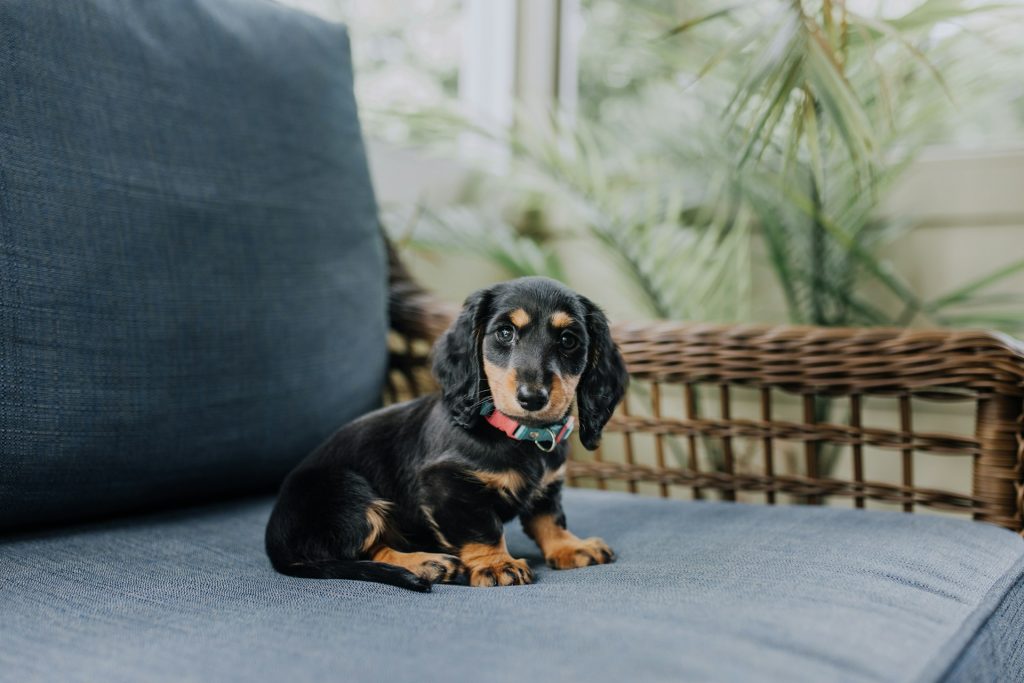Are you thinking about bringing a miniature dachshund into your life? Known affectionately as the mini doxie or mini wiener dog, these charming canines are as unique as they are small. This post will guide you through ten essential things to know before you decide to purchase a mini dachshund, ensuring you’re fully prepared for the delightful yet demanding task of caring for one. From understanding their personality quirks to comprehending their care needs, we’ll cover everything to help you make an informed decision.

History Facts About Miniature Dachshunds
Originating in Germany:
The dachshund breed, which includes both the standard and miniature varieties, originated in Germany over 600 years ago. They were first developed to hunt; long, narrow bodies able to dig into badger dens and a keen sense of smell to track their quarry under the ground. Appropriately, the name “Dachshund” means “badger dog” in German.
Development of the Miniature Variety:
The standard dachshund hunted badgers and a range of other large animals, while the miniature variety was produced for hunting rabbits. The selective breeding process focused on size reduction without sacrificing the breed’s hunting capabilities or its courageous spirit.
Popularity Beyond Hunting:
With the passing centuries, the miniature dachshund turned from a hunting dog to a simple companion. They were a particular favorite in the city among families because of their sweet little characters and manageably small size. By the late 19th century, they had started to be present in dog shows, and popularity had started growing.
Engaging Facts
An Artist’s Dog:
Miniature dachshunds have most popularly become the dog of choice amongst celebrity and artist clientele. Pablo Picasso allegedly had a very close relationship with a certain miniature dachshund named Lump who most likely served as the subject matter for some of his pieces.
A Symbol of Germany:
At one time, this breed was both the standard and miniature dachshunds. This association was further pushed to the top by the dachshund mascot of the 1972 Munich Olympics, who was named Waldi.
The First Olympic Mascot:
Waldi was not only a symbol but also the very first official mascot for the Olympic Games, chosen from the characteristics of the breed as being solid and strong.
How big does a Miniature Dachshund get?
Miniature dachshunds are smaller versions of the standard dachshunds, which have been developed as hunting dogs meant to chase animals, including badgers. These “mini” versions are literally true to their heritage, having the same elongated body and enthusiastic personality but just in a smaller size. A miniature dachshund would be typically under 11 pounds and about 5 to 6 inches at the shoulder when fully matured. This size is therefore best for someone living in an apartment or just simply making it easier to handle compared to the standard dachshund.
What are the cons of a Miniature Dachshund?
While miniature dachshunds are adorable and loving, they come with a set of challenges that prospective owners should consider:
Stubbornness: They can be quite stubborn when it comes to training, needing consistent and patient training techniques.
Spinal Issues: Due to their long backs, they are prone to spinal problems, particularly intervertebral disc disease (IVDD), which requires careful handling and preventive care.
Separation Anxiety: Mini dachshunds are known for their loyalty but can develop separation anxiety if left alone for long periods.
Do Miniature Dachshunds bark a lot?
Yes, miniature dachshunds can be quite vocal. They tend to bark at unfamiliar sounds, people, or other animals. While this makes them excellent watchdogs, it can be a nuisance if not properly managed through training and socialization.
The Difference Between Miniature and Rabbit Dachshund
The miniature dachshund and the rabbit dachshund might sound similar, but they cater to different standards primarily based on size. The rabbit dachshund is even smaller than the mini, typically under 8 pounds, and was historically bred for flushing out small game like rabbits. In contrast, the mini dachshund was designed for slightly larger burrow-dwellers. Despite their size differences, both share similar traits and care requirements.
| Characteristic | Standard Dachshund | Miniature Dachshund | Rabbit Dachshund |
| Lifespan | 12-16 years | 12-16 years | 12-16 years |
| Size | 8-9 inches at the shoulder | 5-6 inches at the shoulder | Less than 5 inches at the shoulder |
| Weight | 16-32 pounds | Under 11 pounds | Under 8 pounds |
| Average Price | $500 – $1,500 | $500 – $3,500 | $1,000 – $4,000 |
Notes:
- Lifespan: All three types tend to have a similar lifespan, which can vary depending on their health, diet, and care.
- Size and Weight: The standard dachshund is noticeably bigger and heavier than both the miniature and the rabbit dachshunds. The rabbit dachshund is the smallest, bred specifically for hunting smaller prey like rabbits.
- Average Price: The cost can vary significantly based on factors such as the breeder’s reputation, geographic location, pedigree, and the specific coat type and color. Generally, rabbit dachshunds are rarer and may command a higher price.
Types of Miniature Dachshunds
The miniature dachshund comes in several varieties, making them quite a diverse breed:
Coat Types: They can have smooth, long, or wire-haired coats, each requiring different grooming attention.
Color Varieties: Mini dachshunds come in a variety of colors and patterns, including dapple, double dapple, brindle, and piebald among traditional shades like red and black and tan. They can also come in exotic or rare colors such as blue or lilac.
How To Take Care of a Miniature Dachshund
Caring for a mini dachshund requires a commitment to their health, happiness, and well-being:
Diet and Nutrition: Provide a balanced diet suitable for a small, active dog. Be mindful of their calorie intake to avoid obesity, particularly because excess weight can exacerbate back issues.
Exercise: Despite their size, mini dachshunds are energetic and need regular exercise to keep them fit and healthy.
Healthcare: Regular vet check-ups are crucial to monitor and manage the breed-specific issues like dental problems and IVDD.
Training and Socialization: Early socialization and consistent training are vital to managing their stubborn streak and tendency to bark.

What is The Average Price of a Mini Dachshund?
Miniature dachshunds are expensive, depending on a variety of circumstances, from pedigree to type of coat and color. On average, one will acquire such a dog from a reputable breeder somewhere between $500 and over $3,500. Other important expenditures to add to the budget when acquiring a miniature dachshund from a breeder would be for continued health care, grooming, and insurance.
READ ALSO: Miniature Dachshund Lifespan: How Long Do Mini Dachshunds Live?
Are Mini Dachshunds Good Family Dogs?
True, but with this one caveat: Mini dachshunds can be really great pets for any family, as they are very loving and loyal. Nevertheless, they are most compatible with families who have older children and who are tender in their handling of them, giving them plenty of space. Their small size and delicate backs mean rough handling by very young children can lead to injuries.
Miniature Dachshund Lifespan
The average lifespan of the miniature dachshund is relatively long, up to 12 to 16 years. That is a great commitment, which an owner should be ready for. To further support a long and healthy life:
- Preventative Health Care: Regular visits to veterinarians are necessary for vaccinations, dental care, and checkups.
- Optimum Nutrition: Feeding them high-quality dog food appropriate for their age, size, and activity level prevents obesity and maintains their overall health.
- Exercise and Mental Stimulation: Engage them physically and mentally; it prevents them from getting obese and helps in keeping the behavior in check.
Training Challenges
Despite being intelligent, miniature dachshunds can be independent and stubborn, causing some difficulty during training. Mostly, positive reinforcement works, because doxies appreciate treats and praises. Some of the important training areas include:
- Housebreaking: Mini dachshunds are quite stubborn and therefore it can be quite a challenge when trying to housebreak them.
- Barking Management: They tend to bark a lot, so teaching them when to bark and when to stay quiet keeps the household in good shape.
- Leash Training: Owing to their hunting instincts, training on a leash is very important in this breed to avoid running after small animals.

Socialization Needs
Mini Dachshunds benefit much from early socialization. Expose them to many different people, sights, sounds, and experiences at an early age. Proper socialization for mini dachshunds ensures the proper growth of a well-rounded dog. It may reduce over-shyness, aggressiveness, and anxiety, a feature important for a breed that is supposed to have a strong attachment to owners.
Potential Health Issues
While miniature dachshunds are generally healthy, they are predisposed to certain genetic health issues aside from the spinal problems mentioned earlier. These include:
– Dental Issues: Due to their small mouths, mini dachshunds are prone to dental overcrowding and related problems.
– Patellar Luxation: A condition where the knee joint (often of a hind leg) slides in and out of place, causing pain. This can be managed with surgery if severe.
– Progressive Retinal Atrophy (PRA): An eye condition that can cause blindness in the affected dogs.
Prospective mini dachshund owners should seek breeders who perform genetic testing on their breeding stock to minimize these risks.
Final Thoughts
The miniature dachshund is really just more than a dog—it’s a friend that comes with so many historical facts and a temperament as long as its body. These tiny, delightful hounds, having transferred from great hunters into cherished members of the family, have used their unique appearance and spirited nature to draw people’s hearts all over the world. The miniature dachshund is very special for a kind of dog: very brave, very playful, and very friendly, fitting absolutely with the home.



2 thoughts on “Miniature Dachshund: 10 Facts You Need To Know”